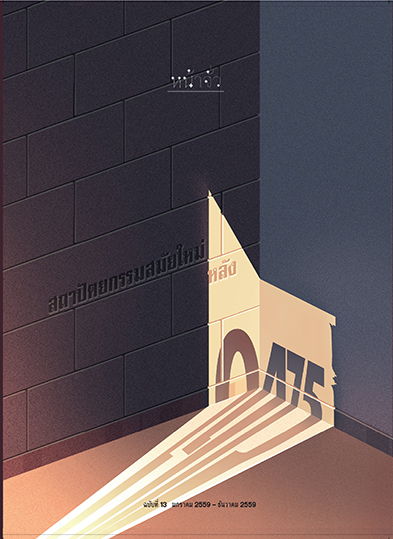การศึกษาการออกแบบสถาปัตยกรรมวิหารพระนอนปางสีหไสยาสมัยต้นรัตนโกสินทร์ถึงสมัยรัชกาลที่ 4/ A study of Architectural Design of Vihara for Reclining Buddha in the Early Rattanakosin Period to King Rama IV
Main Article Content
Abstract
บทคัดย่อ
บทความนี้มีสมมติฐานว่าวิหารพระนอนปางสีหไสยาสมัยต้นรัตนโกสินทร์ถึงสมัยรัชกาลที่ 4 ในบริเวณภาคกลางของไทยที่ชนชั้นนำสร้างหรือปฏิสังขรณ์นั้นมีการออกแบบสถาปัตยกรรมที่เฉพาะตัว โดยใช้วิธีการสืบสวนความหมายของวิหารพระนอน, คติ ความเชื่อต่าง ๆ ที่เกี่ยวข้อง และพัฒนาการของผังวัดที่มีวิหารพระนอนเป็นองค์ประกอบ สรุปเป็นบทบาทและการออกแบบสถาปัตยกรรมวิหารพระนอน 3 แบบ คือ
1. วิหารพระนอนปางสีหไสยาสมัยต้นรัตนโกสินทร์ซึ่งมีฐานะเป็น “องค์ประกอบย่อย” ของวัด และสร้างในคติพระคันธกุฎี มีการสร้างสถาปัตยกรรมให้รับกับจินตภาพแบบมนุษย์ของพระพุทธเจ้า
2. วิหารพระนอนปางสีหไสยาสมัยต้นรัตนโกสินทร์ซึ่งมีฐานะเป็น “องค์ประกอบสำคัญ” ของผังวัด และสร้างในคติมหาบุรุษลักษณะ มีการสร้างสถาปัตยกรรมให้รับจินตภาพแบบเหนือจริงของพระพุทธเจ้า
3. วิหารที่มี “พระนอนประดิษฐานร่วมกับพระพุทธรูปปางอื่น ๆ” และเป็นอาคารซึ่งมีฐานะเป็น “องค์ประกอบรอง” ของผังวัดสมัยรัชกาลที่ 4 และสร้างในคติบริโภคเจดีย์ มีการสร้างสถาปัตยกรรมให้รับกับจินตภาพแบบมนุษย์ของพระพุทธเจ้าของรัชกาลที่ 4
ส่วนการก่อรูปของวิหารพระนอนทั้งหมดนั้นล้วนคำนึงถึงการรับรู้ด้วยสายตา ทั้งการมองจากภายนอกเข้าสู่พระนอนภายในอาคาร และการมองจากภายในอาคารออกไปสู่ภายนอก ดังที่มีการกำหนดลักษณะฐานชุกชี, เสาในประธานและช่องเปิด ซึ่งลักษณะดังกล่าวเป็นการเน้นบทบาทหน้าที่วิหารพระนอนในผังเขตพุทธาวาสของวัด
Abstract
This paper studies about Viharas for Reclining Buddha in the early Rattanakosin period to King Rama IV in the central part of Thailand. It focuses on their architectural uniqueness of the Viharas, built or renovated by Siamese elites. The paper examines the meaning of Viharas for Reclining Buddha, concepts and beliefs relevant to their architectural formation, and their plannings and locations in monastery compounds. According to the scope of this research, three characteristics of the Viharas concerned in this study can be observed here.
1. Vihara for Reclining Buddha in the early Rattanakosin period as a subordinate element in its monastery compound. Its design characteristic is related to the concept of realistic Buddha.
2. Vihara for Reclining Buddha in the early Rattanakosin period as a key element in its monastery compound. Its design characteristic is related to the concept of surrealistic Buddha.
3. Vihara for Reclining Buddha in King Rama IV period, as a secondary element designed according to Paribhogacetiya belief. Its design characteristic is related to the concept of realistic Buddha under King Rama IV period.
In terms of perception, the design leads visitor’s view to the Buddha directly both from outside and from inside the monastery area. This can be also observed in the architectural elements of the Viharas particularly the building’s base, columns and voids designed as to reinforce the roles and function of Viharas of Reclining Buddha.


